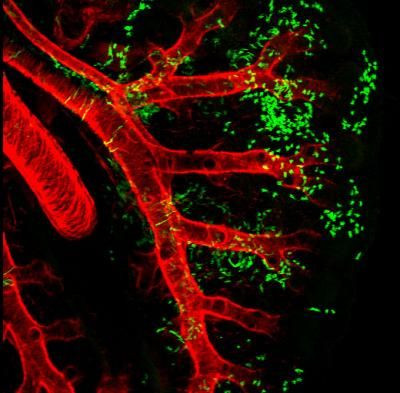A Common Stem Cell For The Heart And Lungs Reveals Intricacies Of Life On Land

The discovery of a common embryonic stem cell in the cardiopulmonary system may help to explain the evolution of life on land, as well as the pathology of pulmonary hypertension — a disease affecting both the lungs and the heart.
A grouping of multi-potent cardiopulmonary mesoderm stem cells, called CPPs, may be discerned from other early embryonic stem cells by the expression of a well-known molecule called Wnt2. These common stem cells form the cardiovascular and pulmonary systems in parallel, although not much is known yet about how a common progenitor cell may influence heart and lung diseases, such as pulmonary hypertension.
But new work highlights the interrelatedness of the two systems, showing that blood vessels connecting the heart to the lung develop in mice even when lung development is inhibited in experimentation, indicating the role of cardiopulmonary stem cells for co-development, researchers from the University of Pennsylvania reported Sunday.
A recent evolutionary adaptation to life outside the ocean, the co-development of the cardiovascular and pulmonary systems couples the function of the heart with the newly vital functioning of the lung, the air-breathing exchanging of gases arguably the most vital for life on land.
Although the coordination between the two systems during embryonic develop is well understood, scientists remain puzzled by the molecular cues guiding the process — and of the implications for managing related diseases in people.
Edward E. Morrisey, director of the Penn Institute for Regenerative Medicine, led the study. "We asked if these progenitor cells are capable of generating both heart and lung derivatives," Morrisey told reporters. "Our data show that Wnt2-positive cells exist prior to lung development and help coordinate lung and heart co-development by generating cell types in both tissues."
For years, Morrisey laboratory has studied the connection, hoping for a breakthrough.
"It's pretty obvious to anyone who has looked at the anatomy of most terrestrial animals that the heart and lung are intimately linked," said Morrisey. "This is even reflected in clinical medicine where in many places, including the Perelman School of Medicine, the Division of Cardiovascular Medicine was once referred to as the Division of Cardiopulmonary Medicine."
Thus, the researchers sought to answer how the two systems co-develop and which molecular signals guide the process, eventually finding the expression pattern of the Wnt2 gene, which occurs in a "unique place in the early embryo — exactly in between the early heart and foregut tube, where the lung will arise from."
The finding allowed researchers to create a model system in mice, whose cardiopulmonary system remains similar to humans after the two species diverged from a common ancestor some 80 million years ago. Employing a cell lineage tracing analysis, the researchers showed that the gene cells generate single clones that, in turn, generate either heart or lung cells. Moreover, these common stem cells, CPPs, may generate the vast majority of early embryonic cell types in both systems.
The study also revealed interrelations between different cell lineages within the lung, including the vascular smooth muscle and airway smooth muscle, which share a common progenitor cell in the lung.
Source: Peng T, Tian Y, Boogerd CJ, Lu MM, Kadzik RS. Common Stem Cell In Heart And Lung Development Explains Adaption For Life On Land. Nature. 2013.



























